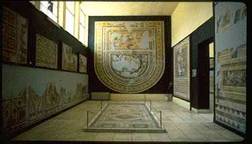
Antioch, today Antakya, is the capital of the Turkish province of Hatay. Situated in the Orontes valley on the slopes of Mount Silipius (altitude 509 metres), 27 kilometres from the Mediterranean and 80 metres above sea-level, Antioch was once known as the "Queen of the Orien t" because of the abundance of its goods and great monuments, and the richness of its culture. Above: goddess Tyke, 'protector' of the town.
Its geographical position meant that the city rapidly became one of the busiest centres on the caravan routes (silk route) to and from the port of Seleucia Pieria (present day Cevlik). This port is just a few kilometres from the mouth of the river Orontes, a river so serpentine and with such turbulent waters that the Arabs nicknamed it 'the rebel'. The first human settlement here, Antigone, dates from 303 BC. It was situated to the north of the present town but rapidly spread.  Seleukos I Nikator, an ex-general of Alexander the Great's, was the founder of the first Antioch, calling it Antiochia in memory of his father. His architect, Xenarius, laid it out in a grid pattern, making it a model of Hellenic town planning. With time, the Seleucid kings, who lived on a now vanished island in the river, embellished the column-lined streets. Later still the town was conquered by Rome and Roman governors settled there. At the time of Antiochus IV Epiphanes, the town was made up of four separately walled settlements all surrounded by an outer wall, which was enlarged by Justinian to a circumference of 12 kilometres.
Seleukos I Nikator, an ex-general of Alexander the Great's, was the founder of the first Antioch, calling it Antiochia in memory of his father. His architect, Xenarius, laid it out in a grid pattern, making it a model of Hellenic town planning. With time, the Seleucid kings, who lived on a now vanished island in the river, embellished the column-lined streets. Later still the town was conquered by Rome and Roman governors settled there. At the time of Antiochus IV Epiphanes, the town was made up of four separately walled settlements all surrounded by an outer wall, which was enlarged by Justinian to a circumference of 12 kilometres. 
This feature inspired the historian Stabon, to call it Tetrapolis, 'four cities'. When, in 64 AD, Pompey made Syria a Roman province, Antioch became the capital and established excellent connections with the surrounding regions. The size of the town and its abundant water supply assured its further growth and development. History records it as having thousands of citizens, not to mention many slaves. A wide, double-porticoed street ran through the town (Cardo maximo in Latin), lined on both sides by villas richly decorated with mosaics. The fame and importance of Antioch lasted until the Arab invasion of the 7th Century, although the town had already begun to go into decline after an earthquake, in 562, which claimed many lives. Antioch was retaken in the 10th. century by Nikephoros II Phokas, but was reoccupied in the next century. In 1098, the Crusaders conquered the town and Antioch was Christian for the next 170 years. Then, in 1268, Sultan Baibas I took the town for the last time and destroyed all that the earthquake had spared. Antioch has been a Province of Turkey since 1939.
 Many vestiges of the splendours of the past remain in the beautiful and important Museum of the Citizens which includes splendid mosaics coming from Daphne. En fact Harbiye, 8 kilometres from Antioch , is built on the site of ancient Daphne, a sacred grove dedicated to Apollo. According to
Many vestiges of the splendours of the past remain in the beautiful and important Museum of the Citizens which includes splendid mosaics coming from Daphne. En fact Harbiye, 8 kilometres from Antioch , is built on the site of ancient Daphne, a sacred grove dedicated to Apollo. According to 
 mythology, the nymph Daphne, fleeing the unwelcome attentions of Apollo, took refuge there and was turned into a laurel tree (Daphne in Greek. Much patronised by the emperors, Daphne became such a magnificent pleasure garden that it put Antioch in the shade, to the extent that certain works of literature referto Antioch as Epidaphne, the city next to Daphne. There are no ruins of Daphne to evoke its past, but people still go there at weekends to enjoy the waterfall and the shade of the trees. For more information this book is very useful:
mythology, the nymph Daphne, fleeing the unwelcome attentions of Apollo, took refuge there and was turned into a laurel tree (Daphne in Greek. Much patronised by the emperors, Daphne became such a magnificent pleasure garden that it put Antioch in the shade, to the extent that certain works of literature referto Antioch as Epidaphne, the city next to Daphne. There are no ruins of Daphne to evoke its past, but people still go there at weekends to enjoy the waterfall and the shade of the trees. For more information this book is very useful:



